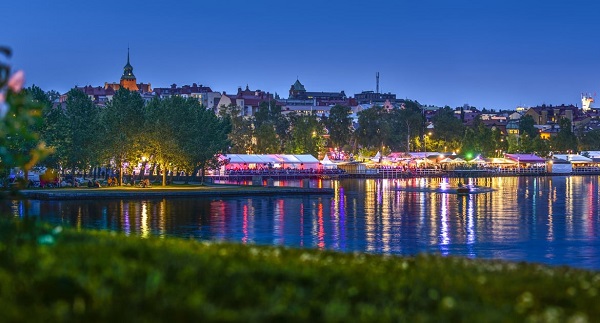International
Europe Can’t Survive Without America

 Sven R Larson
Sven R Larson
But it is not America’s job to save the old continent
The most beautiful place in the world is located smack dab in the heart of northern Europe. It is a small town called Östersund. It stretches along the eastern shore of Storsjön, the “Great Lake”.
Across the strait from Östersund is the island of Frösön. From the farmlands in its center, you can see 30 churches, dense forests, crop fields, and on the far side of the Great Lake a horizon filled with snow-clad mountains. There is a church there, on the Frösön, where the world’s happiest marriages begin: when the bride walks out from the church, she is so overwhelmed by the gorgeous view that she forever loses her ability to speak.
My Swedish hometown is not the only place where Europe brims with beauty. From endless oceanic views in Ireland’s Galway to the meandering riverside cityscape in Budapest; from the midnight sun in Nordkap to the seductive darkness of Palermo; cities that let you marinate in living history, like Munich, Stockholm, Vienna, Rome, and Edinburgh.
Europe has it all. And yet, that continent is slowly, sadly, but inevitably sinking. It is a terrible conclusion to reach, but I see no other path forward for them.
Thanks for reading Larson’s Political Economy!
Subscribe for free to receive new posts and support my work.
There are a multitude of reasons for this; the destruction of such a solid piece of civilization does not come easy. Which, in all honesty, is a tribute to the solidity of the Western project in itself: it takes decades of political and economic mismanagement to bring a continet of 500 million people from the top of world prosperity into the murky quagmire of industrial poverty.
However, that is precisely what the Europeans are now doing. Their decline only seems to be reinforced by every new measure to prevent it.
From an American viewpoint, the increasingly depressing state of Europe has not yet risen to the peak of the news cycle. Perhaps it never will, but the transformation of Europe from the world’s most advanced economy (alongside America) to an economy-class Latin America will have major economic, geo-strategic, and cultural consequences.
Before I dissect those consequences, let me point to the main character traits of Europe’s self-inflicted demise.
Lack of Leadership
If there is one thing Europe does not have, it is visionary political leadership. Not that our own crop of political heralds in Washington are much to brag about, but the new Trump administration actually does have an idea of how to make America better. By his fast-paced, confident leadership, Trump is now challenging the Democrats to step up to the plate; with a little bit of luck, we will go into the coming elections choosing between candidates running on different versions of “America’s best days are ahead of us”.
None of that exists in Europe. To the extent their leaders formulate ideas for the future, it is all about how government can spend more money, regulate more of the private sector, and dole out grants to NGOs to run the internet era of a billboard campaign themed around some empty political slogan. This is endemic in the EU, and it has tangible consequences: just last year the Europeans realized that America was running away with the path to artificial intelligence, while Europe has not yet even built its own Silicon Valley for old-school computer technology.
The realization among Europe’s political leadership that they are losing the AI race led the EU to issue a report suggesting more regulations on private-sector AI development and more government spending to investigate the potentials of the AI revolution.
Such is the European response to every issue, including the so-called green transition. When Americans elected a new president to end the mad dash into EV transporation—and instead let the free market be the arbiter on how we propel ourselves around town—the EU and national government leaders in Europe waged a virtual economic war on fossil fuels, without being even close to replacing it with “renewables”.
The German energy debacle went so far that major German manufacturers accelerated their foreign direct investments in other countries. This is one reason why there will be a lot more auto industry jobs here in America in the coming years. While European political leaders get fixated on some outlandish economic fantasy, America gets down to business, goes to work, and moves forward.
In addition to the fantasy that the green transition should be shoved down people’s throats by government, Europe’s political leaders have surpassed the Biden administration many times over when it comes to immigration—legal and illegal. Instead of asking pragmatic questions about the balance between a mostly uneducated labor supply and Europe’s perennially high unemployment rates, the elected officials and their unelected bureaucrats in Brussels, Paris, Berlin, and other EU capitals forge ahead like drunken cows. They have deliberately unhinged themselves from reality; it is only in a fantasy world free of opposing arguments that you can flood the streets of your cities with endless waves of immigrants, without causing major social, economic, and public safety problems.
A War on Democracy
Again, America is not immune to this kind of make-believe leadership, but unlike America, Europe has no voice of opposition. Where the Tea Party turned MAGA movement showed how true democracy works, forging a nationwide organic alliance of voters, Europe has invented institutions, conventions, policies, and a political culture of efficiently suppressing opposition.
There is no First Amendment in Europe, which politicians in both the EU and national governments have taken advantage of. In what can only be described as a war on the core of democracy, the European political elite is fighting an increasingly aggressive battle against dissenting voices. National governments are formed not to further the will of the people, but to quell the voice of dissent.
Coalitions of resentment against the people have appointed prime ministers in Sweden, Finland, Austria, France. A coalition of resentment is trying to form a functioning government in Germany. Where hatred of a common adversary is the only common denominator, there can be no room for visions. All political eyes remain in the rearview mirror, anxiously trying to keep the distance from the last election results.
People are blinded by a common hatred they cannot see the future.
From the viewpoint of policy, the only thing that these coalitions of resentment can produce is a regurgitation of the past. This explains why there is no debate in Europe over the “green transition” and why there is only token talk about immigration. Prevailing paradigms, which caused people to vote for alternative parties, reign unchallenged.
As do their consequences. In other words, the more Europe’s anti-democratic leaders double down on policies that thwart free speech, choke their economy, and fragment cohesive societies, the more they will distance themselves and their continent from the future.
A Stupid Economy
Europeans pay far more in taxes than we Americans do. Income taxes often start at 30-40 percent—for the lowest incomes—and there are value-added taxes, VATs, on everything they buy. Excise taxes, “green taxes”, fees and administrative charges run amok.
At the same time, they don’t get much more than we do. If anything, they get less of most of things. In health care (which I hope to have time to write more about in closer detail), Europe’s foremost contribution is the waiting list. You have the right to health care, but that does not mean you can get it.
The same is true for the countries in Europe that have elaborate systems of child care: you have the right to it, but that does in no way mean it can find a spot for your kid when the time comes.
Europeans brag about their paid-leave programs. It is true that, e.g., parents can take a lot of time off from work to be with their kids. They also have long vacations. However, since these benefits are mandated by law, they are in no way reflective of what businesses can afford in terms of an absent workforce. Yes, it is nice to be able to be at home with your baby for the first year or 18 months of its life, but during that time your employer needs to hire a replacement.
When I talk to Europeans about their paid-leave system, they often suggest that we Americans have no paid leave at all. I point out that just because government does not provide it, does not mean it does not exist. We prefer to let employers and employees handle the paid-leave issue as part of a workforce benefits package.
Fixated on letting government take care of as much as possible of their lives, Europeans have created a welfare state that demands taxes close to—and sometimes higher than—50 percent of GDP. This is well above the 40-percent line where GDP growth permanently slows down; once the tax burden crosses that mark and no one cares, the country inevitably sinks into economic stagnation.
There is no advancement in the standard of living. Private purchasing power is no longer adequate to keep businesses going. Capital formation stagnates and eventually moves abroad. The tax base is eroded; a consequence-impaired governing coalition of resentment responds with even higher taxes.
All in all, Europe has ended up in a vicious downward economic spiral. Her leaders are unable to understand the problem, let alone offer a solution. Among the many repercussions of this is the slow decline in standard of living that is already passed on from parents to their children: each new generation of Europeans will find life to be a little less prosperous than their parents did.
The Role of America
For all these reasons—lack of leadership, a dwindling democracy, and a stagnant economy—the European continent is unable to break out of its self-inflicted societal stranglehold. But what made it drift into this fog of endless political self-harm?
In one word: America provided the Europeans with a shield of security during the Cold War. Germans, Brits, French, Dutch, Spanyards, and others got so used to living under the protective shield of American military might that they believed they no longer had to think about existential issues. Instead, they could spend their time inventing new entitlements for their welfare states.
Again: make-believe politics. They never thought that their growing welfare states would sink their economies; in fact, economists never thought that this would happen either. I was the first one to point out this relationship, and I did it only a decade ago.
Likewise, Europe’s make-believe politicians thought that they could enjoy free-of-charge American military protection forever. The end of the Cold War did not exactly change their minds: suddenly, they thought they had somehow “won” that war, and that they as the victors could dictate the terms of their own existence—without having to work for it.
When America gradually began orienting itself away from Europe, there was at first massive denial across the old world. Due in no small part to foolish rhetoric from our neocons (both Presidents Bush, Vice President Cheney and his daughter Liz, John Podhoretz, Senator Graham of South Carolina, Irving and Bill Kristol…), the Europeans were led to believe that America would still provide that shield of safety no matter how many other parts of the world we were engaged in.
But not even neocons last forever. Reality began poking through the European bubble of political fantasies during Trump’s first term; after a “breather” during the Biden administration we are now back to the harsh reality where America is asking the Europeans to do what every other nation, or union of nations, is doing: grow up and take responsibility for their own sovereignty.
In other words, America can save Europe, but it is not America’s business to do so.
The rational reaction to this from the Europeans would have been to open a vigorous, public debate over what priorities their countries should make: the welfare state or national defense? But instead of doing just that, they have gone into an Alice in Wonderland-style mental lockdown where politicians in every cardinal direction dispense edicts about throwing Gargantuan amounts of money into military expansion projects that they have no funds for, and no industrial capacity to deliver.
At best, Europe will fragment into regional coalitions of countries, where some will make a future for themselves and others will continue to sink. The four Visegrad states, Poland, Hungary, Czechia and Slovakia, are relatively strong economically. So are the Baltic states.
The Nordic countries could form a strong regional economy, but with Sweden suffering from political deadlocks, high crime, a corrupt government, and a perennially stagnant economy, that outlook is no longer possible.
Germany is an enigmatic entity in this context. If they cannot change their own energy policy, they are going to de-industrialize at a rapid rate. That, in turn, will likely lead to growing political tensions; is therean independent, non-communist East Germany in the cards?
Southern Europe is ironically the most resilient part of that continent. Greece, Italy, Spain, and Portugal have survived centuries of prosperity, poverty, war, and peace. They will find a way to muddle through a glacial but politically and economically visible European implosion.
The comparison to Latin America is more accurate than it might seem. Before World War II, Argentina, Uruguay, and Brazil were among the best, most thriving economies in the world. Then the welfare state happened…
Thanks for reading Larson’s Political Economy!
Subscribe for free to receive new posts and support my work.
Larson’s Political Economy is free today.
But if you enjoyed this post, you can tell Larson’s Political Economy that their writing is valuable by pledging a future subscription.
You won’t be charged unless they enable payments.
Crime
Tucker Carlson: US intelligence is shielding Epstein network, not President Trump

From LifeSiteNews
By Robert Jones
Pam Bondi’s shifting story and Trump’s dismissal of Epstein questions have reignited scrutiny over the sealed files.
Tucker Carlson is raising new concerns about a possible intelligence cover-up in the Jeffrey Epstein case—this time implicating U.S. and Israeli agencies, as well as Trump ally and former Florida Attorney General Pam Bondi.
During a recent broadcast, Carlson discussed U.S. Attorney General Bondi’s refusal to release sealed Epstein files, along with the FBI and DOJ announcement that Epstein did not have a client list and did indeed kill himself.
Carlson offered two theories for Bondi’s words. The first: “Trump is involved—that Trump is on the list, that they’ve got a tape of Trump doing something awful.”
But Carlson quickly dismissed that idea, noting he’s spoken to Trump about Epstein and believes he wasn’t part of “creepy” activities. He also pointed out that the Biden administration holds the evidence and would likely have acted if there were grounds.
10 Shocking Stories the Media Buried Today
#10 – Tucker Carlson has two theories why Pam Bondi won’t release the Epstein Files.
Theory #1: “Trump is involved.”
But Tucker thinks this explanation is not very likely.
That brings us to Theory #2, which is that Tucker believes… pic.twitter.com/Wy8l5NWQvZ
— The Vigilant Fox 🦊 (@VigilantFox) July 8, 2025
Carlson’s second theory: the intelligence services are “at the very center of this story” and are being protected. His guest, Saagar Enjeti, agreed. “That’s the most obvious ,” Enjeti said, referencing past CIA-linked pedophilia cases. He noted the agency had avoided prosecutions for fear suspects would reveal “sources and methods” in court.
The exchange aired as critics accused Bondi of shifting her account of what’s in the files. She previously referenced “tens of thousands of videos of Epstein with children,” but later claimed they were videos of child pornography downloaded by Epstein. Observers say that revision changes the legal and narrative stakes—and raises questions about credibility.
#9 – Pam Bondi changes the story on the “tens of thousands of videos of Epstein WITH children.”
BEFORE: Tens of thousands of videos of Epstein WITH children.
AFTER: Tens of thousands of videos of child p*rn were DOWNLOADED by Jeffrey Epstein.
Credit: @Ultrafrog17 pic.twitter.com/v5I2uulyzA
— The Vigilant Fox 🦊 (@VigilantFox) July 8, 2025
Donald Trump also appeared impatient with the matter. “Are you still talking about Jeffrey Epstein? That is unbelievable,” he said in a video beside Bondi. This clip sparked backlash from longtime Trump supporters, including former Trump advisor Elon Musk, who reposted critical commentary on Trump and Bondi’s comments on X:
Musk previously alleged that Trump was himself implicated in the Epstein files. Although he retracted and apologized for this, he recently suggested that Steve Bannon was also implicated.
However, Carlson’s guest suggested that Bondi’s comments had another purpose. “The lie is a signal to everybody else involved,” he said. “The lie is not for you and me. The lie is for those implicated to say, ‘No matter what, we will protect you.’”
#7 – Guest leaves Tucker Carlson speechless with an interesting theory about the Epstein File cover-up.
“The lie is a signal to everybody else involved in the scheme that to the ultimate ends, the United States government will go to protect all of you.”
“The lie is not for you… pic.twitter.com/DWm3VwBmwF
— The Vigilant Fox 🦊 (@VigilantFox) July 8, 2025
The files in question remain sealed. It is unclear whether further revelations about Epstein will come to light, but Trump’s comments are not going to make the issue go away.
International
No more shoes off: Trump ends TSA’s decades-old rule

 MxM News
MxM News
Quick Hit:
The Trump administration is phasing out one of the most despised airport security policies in America: the requirement to remove shoes during TSA screening.
Key Details:
- Passengers will no longer be required to remove their shoes at airport security checkpoints in coming weeks.
- The change is rolling out at Baltimore, Fort Lauderdale, Cincinnati, Portland, Philadelphia, and Piedmont Triad airports.
- White House Press Secretary Karoline Leavitt confirmed the policy reversal on Tuesday morning.
Diving Deeper:
The Trump administration announced it is ending the much-loathed Transportation Security Administration rule requiring passengers to remove their shoes during security checks, a mandate that has frustrated Americans since its introduction nearly two decades ago.
The change is being implemented first at Baltimore/Washington International Airport, Fort Lauderdale International Airport, Cincinnati/Northern Kentucky International Airport, Portland International Airport, Philadelphia International Airport, and Piedmont Triad International Airport in North Carolina, according to CBS News. The policy will expand to additional airports nationwide in the coming weeks.
White House Press Secretary Karoline Leavitt shared the news on X, posting, “Big news from [the Department of Homeland Security]!” Tuesday morning. A TSA spokesman told The New York Times that “TSA and DHS are always exploring new and innovative ways to enhance the passenger experience and our strong security posture,” suggesting the policy change is part of broader improvements under President Trump’s leadership.
The policy to remove shoes was first instituted in 2006, stemming from the December 2001 attempt by Richard Reid, known as the “shoe bomber,” to ignite explosives hidden in his shoes on a flight from Paris to Miami. Reid was sentenced to life in prison after pleading guilty to terrorism charges, but critics have argued the policy punishes every American traveler for the actions of one terrorist nearly 25 years ago.
Before the update, travelers in the TSA PreCheck program were already exempt from removing shoes, belts, and jackets. Now, under President Trump’s directive to reduce pointless regulatory burdens, the policy is being eliminated for all travelers.
-

 MAiD2 days ago
MAiD2 days agoCanada’s euthanasia regime is already killing the disabled. It’s about to get worse
-

 Daily Caller16 hours ago
Daily Caller16 hours agoUSAID Quietly Sent Thousands Of Viruses To Chinese Military-Linked Biolab
-

 Alberta12 hours ago
Alberta12 hours ago‘Far too serious for such uninformed, careless journalism’: Complaint filed against Globe and Mail article challenging Alberta’s gender surgery law
-

 Censorship Industrial Complex23 hours ago
Censorship Industrial Complex23 hours agoCanadian pro-freedom group sounds alarm over Liberal plans to revive internet censorship bill
-

 Fraser Institute1 day ago
Fraser Institute1 day agoBefore Trudeau average annual immigration was 617,800. Under Trudeau number skyrocketted to 1.4 million from 2016 to 2024
-

 International2 days ago
International2 days agoChicago suburb purchases childhood home of Pope Leo XIV
-

 Daily Caller2 days ago
Daily Caller2 days ago‘I Know How These People Operate’: Fmr CIA Officer Calls BS On FBI’s New Epstein Intel
-

 Economy1 day ago
Economy1 day agoThe stars are aligning for a new pipeline to the West Coast

